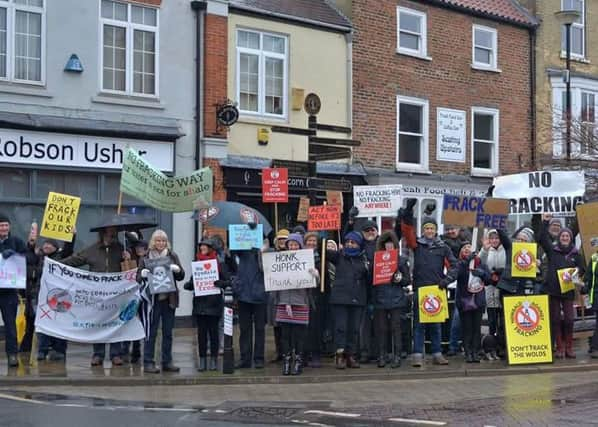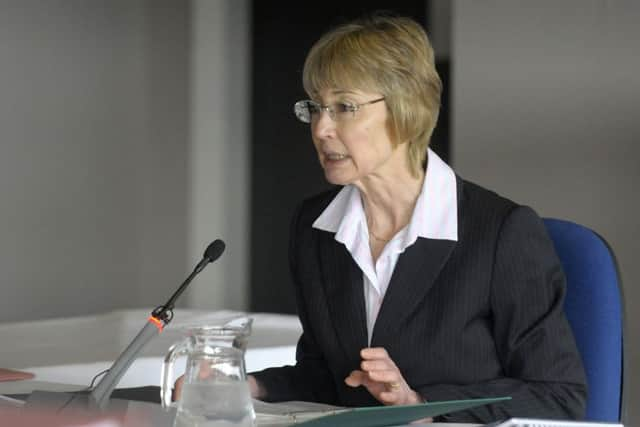Planning inspector opens crucial inquiry into shale gas drilling applications


Demonstrators, both for and against the controversial method of extracting gas from deep lying rocks, spoke about the potential benefits and dangers from the development of a shale gas industry in rural Lancashire.
Inside the stadium, the Government-appointed planning inspector Ms Wendy McKay opened the hearing with the noise of demonstrators clearly heard in the inquiry room overlooking the pitch at Bloomfield Road.
Advertisement
Hide AdAdvertisement
Hide AdShe outlined how the appeal would progress and listed speakers, both for the appellant Cuadrilla and the defendant Lancashire County Council.


It was the county councillors who refused in June last year, the energy company’s two bids to drill and test frack on land at Roseacre and at Little Plumpton off Preston New Road and also to install monitoring arrays at each site.
She said she had already driven around both sites and stopped to look from the highway before coming to the hearing, but would set aside time for accompanied visits on Wednesday, February 24.
She added: “Having taken into account submissions from various parties it would be useful to have a second day to look at the sites particularly in respect of the array proposals which cannot be seen form the highway.
Advertisement
Hide AdAdvertisement
Hide Ad“That may have to take place after the inquiry has finished.


“It may also be useful to carry out a site visit at night.”
Cuadrilla’s representative Nathalie Lieven QC said both sites were covered by high court injunctions and a list of people who would be going on the visits would be needed.
She then outlined Cuadrilla’s initial opening statement to support their view that fracking should be allowed.
She said the inspector should judge the appeal on planning grounds only, not on environmental or health issues which opponents would cite.
Advertisement
Hide AdAdvertisement
Hide AdShe added: “This is not an inquiry into the rights or wrongs of shale gas extraction and how it relates to the UK’s climate obligations.
“This is a planning inquiry under section 78 of the Town and Country Planning Act 1990 into planning considerations material to the determination of the appeals.”
She said the Government supported shale gas and regarded it as an issue of national importance.
She added the decision should be made assuming that regulatory regimes put in place to cover environmental impact would be effective.
Advertisement
Hide AdAdvertisement
Hide AdShe said Cuadrilla’s evidence would show the impact on noise, visual impact and traffic would show that fracking rigs would be low impact.
Next to give an opening statement was Babs Murphy from the North and Western Lancashire Chamber of Commerce which was supporting Cuadrilla.
She said their evidence to the inquiry would show that the developments did not conflict with planning guidelines and that they would result in the creation of skilled jobs and opportunities for local businesses and people.
She said: “The chamber believes that the shale gas sector can play an important role in contributing to the economic growth of Lancashire.
Advertisement
Hide AdAdvertisement
Hide Ad“Lancashire business is willing and ready to exploit shale gas and business is ready to invest.
“Jobs, new skills and training are badly needed in the county and I will show that shale gas is well placed to provide them.
“The county council has demonstrated a lack of political will and come under extreme pressure from interest groups parachuted into the area.”
For Lancashire County Council, Alan Evans said their evidence would show the developments proposed in the appeals would cause a significant adverse impact on areas which were a valuable rural buffer between the urban areas of Blackpool and Kirkham.
Advertisement
Hide AdAdvertisement
Hide AdHe said: “They were refused against the county council’s officers’ recommendations. That is an example of local democracy in action.”
He said the Preston New Road application was refused, firstly due to an unacceptable adverse impact on the landscape, the urbanisation of rural areas and the effect on residents.
And secondly, unacceptable noise levels which would be detrimental to residents.”
He said the development at Roseacre would be counter to the minerals and waste local plan. He said the heavy lorries needed for the development would have an adverse impact on the rural roads.
Advertisement
Hide AdAdvertisement
Hide AdMs Estelle Dehon spoke for Friends of the Earth Ltd saying they did not agree with the assertion of the appellant and that people’s health, climate change and waste issues were also admissible.
Robin Green, speaking for the Roseacre Awareness Group ,said if the development got the go-ahead it would radically change the nature of the rural area.
He added: “The noise from the site day and night will be far in excess of what it is currently.”
Ashley Bowes, outlining the coming arguments from the Preston New Road Action Group, said: “Residents have quite rightly raised significant and serious objections.
“The scale of change will be significant and adverse.
Advertisement
Hide AdAdvertisement
Hide Ad“Mr Mike Stigwood has undertaken five weeks of study of noise. It is the most robust evidence on noise of any party at the appeal. 42 decibels will result in significant adverse effects on those living nearby including Foxwood Chase.”
Following the last of the opening statements, the inspector invited Cuadrilla to begin to present evidence to show why the planning refusals should be overturned.
First witness for Cuadrilla was Mark Smith, from Arup, who would outline why the applications would not go against planning guidelines.
He said initial work on the fracking sites would take two and a half years.
Advertisement
Hide AdAdvertisement
Hide AdFirstly the monitoring arrays would be established around a year beforehand then the sites would take between four and five months to construct then the first well would be drilled.
He said: “That takes longer for the initial well than for subsequent wells – around five months to drill
“The second well would take around three months duration. That would be followed by fracturing of both wells and initial flow testing. Fracturing takes two months and flow testing three months. That is when gas is flared.”
Next, extended flow testing would take place after which the sites would be restored and the wells capped. He said the extended flow testing would not need flare stacks as the gas would be channelled into the mains.
Advertisement
Hide AdAdvertisement
Hide AdA typical array site would be unnoticeable only requiring a small green cabinet for seismic arrays. They monitors small movements below ground and send a signal to the drill site. He said a “traffic light” system would be strictly imposed. If amber the pressure is adjusted if it reaches red the operations are halted.